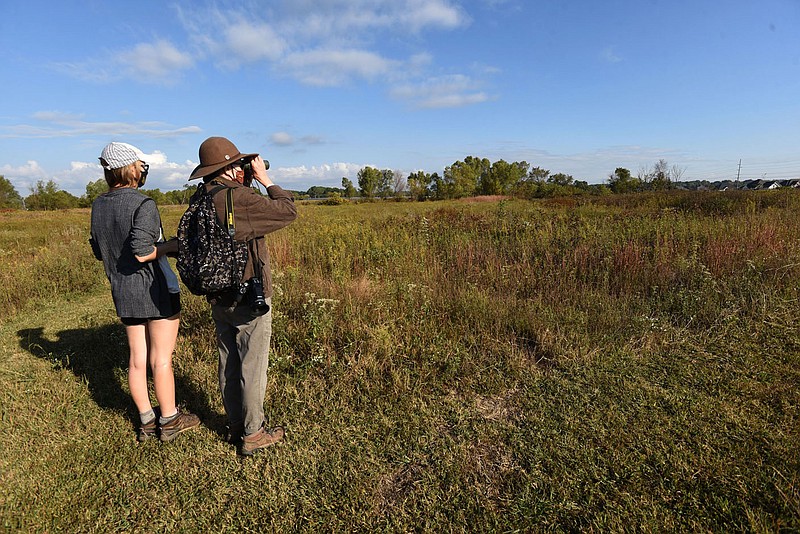Wearing waders might be extreme during a visit to Woolsey Wet Prairie. Lacing up a pair of waterproof shoes might be in order.
The 44-acre prairie on the west edge of Fayetteville is dry much of autumn. An inch or two of rain can change that. The tract retains water that's a magnet for migrating waterfowl, songbirds and all sorts of wildlife beneath the sky.
The ground was dry, almost crunchy, on Oct. 9 when Joe Neal and Joan Reynolds led a small group along the mowed paths at Woolsey Wet Prairie. A couple of ponds have water all year, even in summer.
[Don't see the video above? Click here to watch: https://www.youtube.com/embed/x4x8_9fh2QE]
During the wet season, especially in the spring, the prairie is a wetland, Neal explained during a leisurely walk. He and Reynolds are active in the Northwest Arkansas Audubon Society.
All types of wildflowers, native grasses and plants wave in the breeze from spring through autumn. Common and rare birds are seen overhead and resting on branches. The city of Fayetteville owns Woolsey Wet Prairie, which is open to everyone for exploring.
The 44-acres is part of a larger tract the city purchased in 1999. Fayetteville's westside wastewater treatment plant was built on part of the property. Prairie restoration took place on the 44 acres to offset 10 acres of wetland altered through construction of the plant, says the city of Fayetteville website.
Samuel and Matilda Woolsey built their home on the site in 1842 and raised 13 children in a home that still stands on the property.
"The settlers couldn't plow right here because it was too wet," Neal said.
Prairie habitat was brought back to the 44 acres. Seeds of native vegetation were sown and some low earthen berms were built to help the land hold water. Moisture is the draw for shore birds and waterfowl.
"We've seen white ibis here," Reynolds said. "It brings in different kinds of ducks and lots of herons."
Woolsey Wet Prairie is a remnant of what was once thousands of acres of tallgrass prairie in Northwest Arkansas, Neal said. He paused in mid stroll to show stands of big bluestem grass, foxtail and switchgrass. Milkweed is abundant. Monarch butterflies lay their eggs on milkweed and take nourishment from it.
Visitors stroll past stands of cattails, evidence of water that pools on the prairie during wet times. In autumn, the hot-dog-shaped cattail heads become white and fluffy like cotton candy. Pods of bright-orange goldenrod are sights to behold.
Neal wore his ever-present field vest and binoculars with an eye out for feathers.
"It's pretty quiet bird-wise this morning," he said. "I say that because that usually gets them to pop out."
It worked. Almost immediately a red-bellied woodpecker and red-tailed hawk were seen. Neal jumped for joy at the sight of a western meadowlark.
"There's lots of eastern meadowlarks here," he noted. Spotting a western meadowlark is a trophy sighting for ardent birders.
As the morning warmed, Reynolds pointed to villages of grasshoppers flitting about on the vegetation. They're breakfast, lunch and dinner to the prairie's birds.
Neal enjoyed another ah-ha moment farther down the trail.
"Look! A male scissor-tail (fly catcher) and a female kingfisher both together in the same tree. That's a first for me," he hollered in a voice dripping with glee.
Insects, too, excite him.
"Look at that dragonfly! Oh my don't move," Neal rejoiced, hunkered close to the ground to get a sharp picture of a blue-faced, meadow-hawk dragonfly.
There's life beneath the prairie soil, too. The Osage burrowing crawfish thrives at Woolsey Wet Prairie, Reynolds said. The crawdads build little walls of mud around their burrow holes.
"Another great thing about this place," Neal said, "it's great for student research projects. It's close to the university, other colleges and high schools so students doing insect or reptile research don't have to travel far.
"And of course, birders from across Arkansas come here because they might see birds that are only on prairies like this."


More News
Visit Woolsey Wet Prairie
Woolsey Wet Prairie is located at 15 S. Broyles Ave., Fayetteville. Turn into the entrance of the city’s west-side wastewater treatment plant. Parking and the prairie entrance is on the right.
Source: City of Fayetteville
Flip Putthoff can be reached at fputthoff@nwadg.com or on Twitter @NWAFlip.
